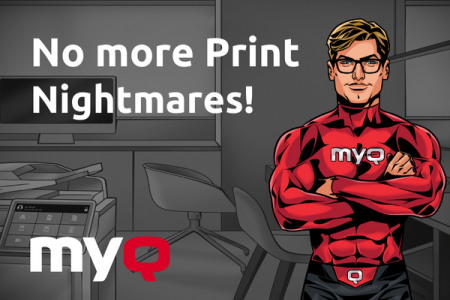PrintNightmare und Resting Easy mit MyQ
14/03/2023

Übermäßige gemeinsame Nutzung, Druckertreiber und unsicheres Verwaltungsverhalten können zu systemischen Risiken führen.
"PrintNightmare" ist der Name für eine Reihe schwerwiegender Sicherheitslücken im Windows Print Spooler-Dienst(CVE-2021-34481 und CVE-2021-34527). Während diese Probleme Mitte 2021 an die Öffentlichkeit gelangten, spuken die Bedingungen, die dazu führten, immer noch im Schlaf der Systemadministratoren.
Die PrintNightmare-Schwachstelle ermöglichte es jedem Benutzer im Netzwerk eines Unternehmens, den Domänencontroller über den Windows Spooler auszunutzen und die Microsoft Active Directory zu kompromittieren. Angreifer konnten Code mit Systemprivilegien ausführen, solange sie über die Anmeldeinformationen eines beliebigen authentifizierten Benutzers verfügten.
Der Print Spooler-Dienst vonMicrosoft ist der Netzwerkvermittler zwischen Druckern und einzelnen Computern. Er nimmt Druckaufträge vom Computer entgegen, stellt sicher, dass Druckerressourcen verfügbar sind, und legt die Reihenfolge der Druckaufträge in der Warteschlange fest. Bei Domänencontrollern ruft der Print Spooler-Dienst die Liste der Drucker aus Active Directory ab und prüft, ob der print server erreichbar ist oder ob der Drucker noch freigegeben ist.
Ja, der Spooler spielt eine wichtige Rolle , aber er ist nicht unbedingt erforderlich. Obwohl einige Druckverwaltungslösungen ihn ausgiebig nutzen, ist er seit langem als Sicherheitsrisiko anerkannt. Microsoft empfiehlt, dass Domänencontroller und Active Directory diesen Dienst deaktivieren, wenn er nicht benötigt wird.
Es besteht die Gefahr des Oversharing
Die Probleme mit Windows Spooler wurden durch eine Kommunikationspanne zwischen Sicherheitsforschern und Microsoft noch verschlimmert. Kurz gesagt, zwei Forscher teilten ihre Erkenntnisse - und einen Konzeptnachweis - über diese Schwachstelle mit, bevor Microsoft ein voll funktionsfähiges Patch für sie vorbereitet hatte. Diese Forschungsergebnisse verbreiteten sich wie ein Virus, was nicht gut war. Darüber hinaus benötigte Microsoft mehrere Patches - nicht nur einen -, um die meisten Probleme zu beheben. Eine der wichtigsten Korrekturmaßnahmen bestand darin, dass die Benutzer über Administratorrechte verfügen müssen, wenn sie die Funktion "Zeigen und Drucken" zur Installation von Druckertreibern verwenden. Es gab auch Beschwerden darüber, wie diese Schritte umgesetzt wurden.
Praktizieren Sie eine sichere Computernutzung?
Die vorzeitige Veröffentlichung von Forschern war nur der sichtbare Anfang des Problems. PrintNightmare wurde durch Admins, die "unsicheres Rechnen" praktizierten, wirklich beschleunigt.
"Dies ist auf die gängige Praxis der gemeinsamen Nutzung von Treibern über das Netzwerk mittels Microsoft Print Spooler zurückzuführen", so Václav Salava, Senior Support Specialist bei MyQ. "Ich würde dieses Verhalten als systemisch riskant bezeichnen."
Der Print Spooler ist zwar wichtig, aber als bekanntes Sicherheitsrisiko sollte er kein obligatorisches Element in jeder Druckverwaltungssoftware sein. Er wurde erstmals weltweit bekannt, als er in den Stuxnet-Wurm als die berühmte Zero-Day-Schwachstelle CVE-2010-2729 integriert wurde. Denken Sie daran, dass sogar Microsoft empfiehlt, diese Funktion zu deaktivieren.
Ruhig schlafen mit MyQ
Bei MyQ gab es keine Alarme wegen des PrintNightmare- und des Print-Spooler-Problems - und dafür gibt es zwei gute Gründe. Erstens benötigtMyQ X den Print-Spooler-Dienst nicht. Zweitens hat MyQ seine Kunden seit langem ermutigt, ihre Umgebung ohne gemeinsame Nutzung des Druckertreibers einzurichten. "Der Druckertreiber kann direkt auf den Client-Computern installiert werden", so Václav. Mit MyQ X kann dies von einem Administrator über ein Verwaltungsskript für die Verteilung von Treibern durchgeführt werden. Darüber hinaus gibt es mehrere treiberlose Druckmethoden, die die Kunden ebenfalls nutzen können. Zu diesen Alternativen gehören AirPrint, Web-Upload, E-Mail-Druck und mobiles Drucken mit dem MyQ X Mobile Client.
Für bessere und sicherere Träume sollten Sie den Print Spooler-Dienst in den Ruhezustand versetzen.
Das neue 10.1-Upgrade sorgt mit seiner Terminal-Druckvorschau für weniger Verwirrung bei den Dokumenten, fügt mehr Easy-Funktionen hinzu und ermöglicht ein Microsoft Single Sign-On-Erlebnis. Und das ist erst der Anfang...
MyQ X
3 Minuten lesen



